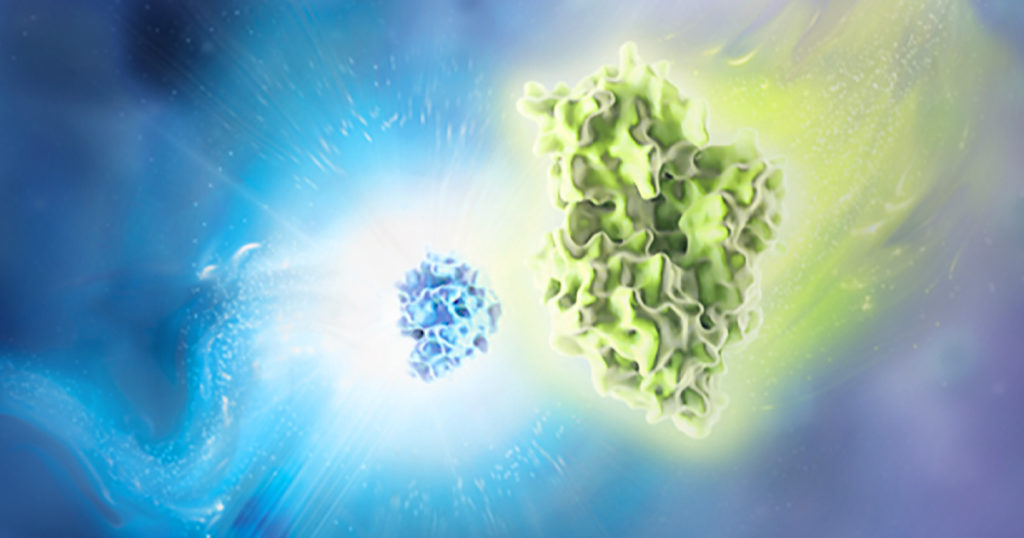This post is written by guest blogger, Amy Landreman, PhD, Sr. Product Manager at Promega Corporation.
Oxygen is necessary for animal life. It’s essential for cellular respiration and the production of energy (ATP) we require to survive. Given the need for oxygen, it isn’t surprising that our bodies have evolved ways to sense and adapt to decreased oxygen conditions (hypoxia). We can increase the production of new blood vessels by producing vascular endothelial growth factor (VEGF) or increase red blood cell (RBC) production by increasing the levels of eythropoietin (EPO), the hormone that plays a key role in the production of RBCs. But how does our body sense low oxygen, increase EPO levels, and kick our RBC production into gear? Nobel laureate Gregg L. Semenza has been honored for his contributions to our understanding of this process, and his research demonstrates the value of reporter genes and bioluminescence for studying gene regulation.

In 2019 three researchers, William G. Kaelin Jr., Sir Peter J. Ratcliffe and Gregg L. Semenza were awarded the Nobel Prize in Physiology or Medicine for their discoveries of how cells sense and adapt to oxygen availability. We’ve previously taken a look at some of the pioneering work done by Kaelin and Ratcliffe to characterize key protein interactions involved in the hypoxia response. Here we will focus on some of the research done by Semenza lab that established a foundational understanding of key genomic regulatory elements that allow genes like EPO and VEGF to be upregulated in response to hypoxic conditions.
This work required the use of a genetic reporter. Reporter genes allow putative genomic regulatory regions to be cloned in front of an easily measured reporter protein. The reporter construct can be transiently transfected into a target cell of interest and reporter levels quantified as a surrogate for target gene expression. (Learn more about reporter gene assays here.)
Semenza et al (1991) used the chloroamphenicol acetyltransferase (CAT) enzyme, a common reporter at the time, to understand the molecular mechanism of EPO induction under low oxygen conditions. By creating a CAT reporter construct that contained the 3’ region of the EPO gene, they demonstrated that a 256-bp region could lead to increased expression of the CAT reporter when cells were cultured in low oxygen conditions. The significance of this genomic sequence became clear when it was observed that even when the entire EPO gene 5′-flanking sequence was deleted, the gene remained fully hypoxia inducible.
In a follow-up study functional dissection of this 256-bp sequence was performed to better understand exactly what genomic elements were critical for the hypoxic response (Semenza and Wang 1992). Again, Semenza turned to reporter assays. In these assays, DNA regions were chopped up and mutated to understand the specific DNA sequences that are critical for gene regulation.
Because this work was done by transient transfection, normalization of the experimental reporter was important to demonstrate that observed changes in reporter expression were caused by differences in the DNA sequence and not from differences in things like transfection efficiently. Semenza used a dual-reporter approach to accomplish this. A CAT experimental reporter was normalized by a constitutively expressed β-galactosidase control.
This work demonstrated that within the original 256=bp sequence, a 50-bp sequence could be fully functional as a hypoxia-inducible enhancer. This enhancer, which Semenza termed a hypoxia response element (HRE), bound several nuclear factors in hepatoma cells: one that was constitutive, and one that was induced by low oxygen levels, consequently termed the hypoxia-inducible factor 1 (HIF-1) by Semenza.
The work of the Semenza laboratory continued to explore the role of HIF proteins in regulating the expression of genes critical for the cellular response to low oxygen. Semenza et al (1996) characterized the hypoxia response elements in the promotersof the glycolytic enzymes ALDA, ENO1, and Ldha, again using reporter genes to determine the DNA sequences required to regulate expression of these genes in hypoxic conditions. The lab transitioned to using a firefly luciferase (Fluc) reporter gene for much of this work. This provided a faster, more sensitive reporter option compared to CAT. They continued to use B/Gal for normalization of the Fluc response.
This work demonstrated the essential role of HIF-1 in regulating the activation of ALDA, ENO1, and Ldha transcription in hypoxic cells. Interestingly, the 68-bp ENO1 sequence, which contains three HIF-1 binding sites, was the most powerful HRE identified at the time. This work helped to understand the molecular mechanism behind one major cellular adaption of severe hypoxia: the transition from oxidative phosphorylation to glycolysis as the principal means of generating ATP.
The work of the Semenza laboratory continues today, with one area of focus to better understand the role of HIF-1 in cancer progression. Zhang et al (2015) looked specifically at the role of HIF-1 in breast cancer progression with a focus on understanding how hypoxic conditions in the tumor impact expression of CD47. CD47 is a cell surface protein that is involved in maintaining cancer stem cells and enables cancer cells to avoid destruction by macrophages. At the time of this study, the human genome sequence was now available and potential HIF binding sites were identified in the CD47 gene.
To functionally characterize the potential HRE sequences the Semenza team again used a dual-reporter approach. However, they had now transitioned to a dual-luciferase method using Fluc as the experimental reporter and Renilla luciferase as the control for normalization. This Dual-Luciferase Reporter Assay System allowed for more efficient, sequential measurement of both reporters from the same cell, eliminating the need to split lysates and perform B/Gal measurement in a separate assay as they were previously doing.
Using this approach, they determined that cellular hypoxia increased normalized Fluc expression when expressed behind either of the putative CD47 HREs. Together with other results, the authors concluded that HIF-1 binds directly to the CD47 promoter to activate gene transcription. This work provided mechanistic insight into the way that breast cancer cells can avoid phagocytosis and how cancer stems cells are maintained, suggesting that HIF inhibitors could be a potential treatment strategy.
A lot has been learned by the Semenza lab and others since the original identification of HREs and HIF proteins. Multiple forms of HIF have been characterized, the process of HIF regulation has been uncovered, and many genes have been found to be regulated as part of the cellular hypoxic response. We now have a better understanding of how alterations in oxygen homeostasis contribute to many human diseases, providing potential disease treatment strategies. A study of this work also demonstrates the importance of early molecular biology tools in genomic analysis and the important role reporter assays have played in the functional characterization of genomic regulatory sequences.
2021 marks 30 years since the first firefly luciferase vectors and reagents became available as products for the research community. As we celebrate this milestone, it is exciting to look back and see how these tools have enabled researchers like Dr. Semenza to make significant advancements in understanding fundamental mechanisms in cellular biology that continue to be built upon today.

To learn more about the last 30 years of bioluminescent innovations and the discoveries they’ve enabled, please visit our 30th anniversary celebration page.
Literature cited:
Semenza et al. (1991). Hypoxia-inducible nuclear factors bind to an enhancer element located 3′ to the human erythropoietin gene. Proc. Natl. Acad. Sci. 88(13): 5680–5684.
Semenza and Wang (1992) A nuclear Factor induced by hypoxia via de novo protein synthesis binds to the human erythropoietin gene enhancer at a site required for transcriptional activation. Mol Cell Biol 12(12): p. 5447-5454.
Semenza et al. (1996) Hypoxia response elements in the aldolase A, enolase 1, and lactate dehydrogenase A gene promoters contain essential binding sites for hypoxia-inducible factor 1. J Biol Chem 271 (51): pp. 32529–32537.
Zhang et al. (2015) HIF-1 regulates CD47 expression in breast cancer cells to promote evasion of phagocytosis and maintenance of cancer stem cells. Proc. Natl. Acad. Sci. 112 (45) E6215-E6223.
Amy is a Sr. Product Manager at Promega Corporation. Her primary responsibility is managing the product life cycle and new product roadmap for the bioluminescent reporter and transfection product areas. Her favorite part of this job is identifying unmet needs within the scientific community and communicating these needs across the organization to create useful new products. Amy received her BS degree in Botany and PhD in Molecular and Environmental Toxicology from the University of Wisconsin-Madison and worked as an applied toxicologist before transitioning to roles product technical support and product management.
Latest posts by Promega (see all)
- One Health and H5N1: Promega’s Commitment to Holistic Solutions - April 8, 2025
- Overcoming qPCR Inhibitors: Strategies for Reliable Quantification - March 13, 2025
- Celebrating Creativity and Innovation: The 2025 Promega Employee Art Showcase - February 4, 2025
